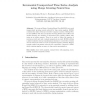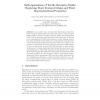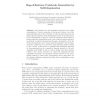WSOM
2009
Springer
14 years 6 months ago
2009
Springer
We propose Merge Growing Neural Gas (MGNG) as a novel unsupervised growing neural network for time series analysis. MGNG combines the state-of-the-art recursive temporal context of...
WSOM
2009
Springer
14 years 6 months ago
2009
Springer
Abstract. We show how the “Online Sparse Coding Neural Gas” algorithm can be applied to a more realistic model of the “Cocktail Party Problem”. We consider a setting where ...
WSOM
2009
Springer
14 years 6 months ago
2009
Springer
In our earlier work, we found that feature space induced by tactile receptive fields (TRFs) are better than that by visual receptive fields (VRFs) in texture boundary detection t...
WSOM
2009
Springer
14 years 6 months ago
2009
Springer
WSOM
2009
Springer
14 years 6 months ago
2009
Springer
Vector quantization methods are confronted with a model selection problem, namely the number of prototypical feature representatives to model each class. In this paper we present a...
WSOM
2009
Springer
14 years 6 months ago
2009
Springer
Abstract. This paper presents a new methodology for missing value imputation in a database. The methodology combines the outputs of several Self-Organizing Maps in order to obtain ...
WSOM
2009
Springer
14 years 6 months ago
2009
Springer
This paper discusses biological aspects of self-organising maps (SOMs) which includes a brief review of neurophysiological findings and classical models of neurophysiological SOMs...
WSOM
2009
Springer
14 years 6 months ago
2009
Springer
Bag of features is a well established technique for the visual categorisation of objects, categories of objects and textures. One of the most important part of this technique is co...
WSOM
2009
Springer
14 years 6 months ago
2009
Springer
Abstract. SOMs have proven to be a very powerful tool for data analysis. However, comparing multiple SOMs trained on the same data set using different parameters or initialisation...
WSOM
2009
Springer
14 years 6 months ago
2009
Springer
The complex phenomena of political science are typically studied using qualitative approach, potentially supported by hypothesisdriven statistical analysis of some numerical data. ...



